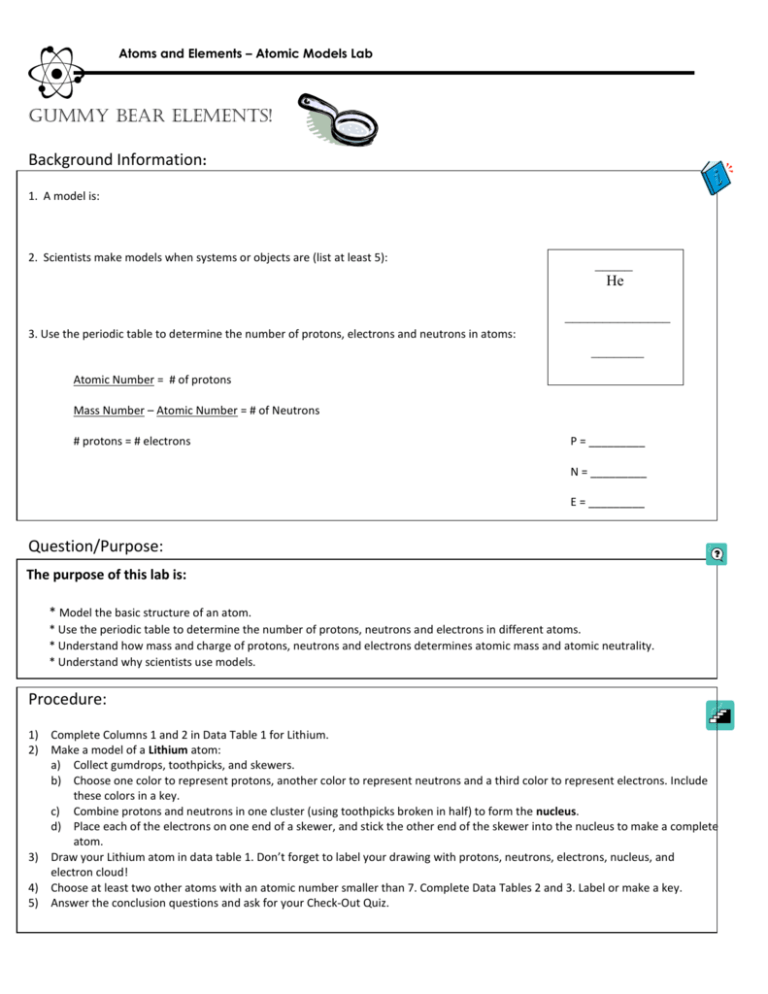Gummy Bear Molecules
advertisement

Atoms and Elements – Atomic Models Lab Gummy Bear Elements! Background Information: 1. A model is: 2. Scientists make models when systems or objects are (list at least 5): _____ He ______________ 3. Use the periodic table to determine the number of protons, electrons and neutrons in atoms: _______ Atomic Number = # of protons Mass Number – Atomic Number = # of Neutrons # protons = # electrons P = _________ N = _________ E = _________ Question/Purpose: The purpose of this lab is: * Model the basic structure of an atom. * Use the periodic table to determine the number of protons, neutrons and electrons in different atoms. * Understand how mass and charge of protons, neutrons and electrons determines atomic mass and atomic neutrality. * Understand why scientists use models. Procedure: 1) Complete Columns 1 and 2 in Data Table 1 for Lithium. 2) Make a model of a Lithium atom: a) Collect gumdrops, toothpicks, and skewers. b) Choose one color to represent protons, another color to represent neutrons and a third color to represent electrons. Include these colors in a key. c) Combine protons and neutrons in one cluster (using toothpicks broken in half) to form the nucleus. d) Place each of the electrons on one end of a skewer, and stick the other end of the skewer into the nucleus to make a complete atom. 3) Draw your Lithium atom in data table 1. Don’t forget to label your drawing with protons, neutrons, electrons, nucleus, and electron cloud! 4) Choose at least two other atoms with an atomic number smaller than 7. Complete Data Tables 2 and 3. Label or make a key. 5) Answer the conclusion questions and ask for your Check-Out Quiz. Atoms and Elements – Atomic Models Lab Observations/Data: Data Table 1: Lithium Atom Complete the Periodic Table Find Number of Protons, Neutrons and Electrons P = _________ (color: ) _____ Li N = _________(color: ) ______________ E = _________ (color: ) Drawing _______ Data Table 2:_________________ Complete the Periodic Table Find Number of Protons, Neutrons and Electrons P = _________ (color: ) N = _________ (color: ) E = _________ (color: ) Drawing _____ ______________ _______ Data Table 3:_________________ Complete the Periodic Table _____ ______________ _______ Find Number of Protons, Neutrons and Electrons P = _________ (color: ) N = _________(color: ) E = _________(color: ) See Ms. G-Wood for your Check-Out Quiz! Drawing Atoms and Elements – Atomic Models Lab Conclusion Questions: (Answer in full sentences) 1. Are atomic models accurate representations of real atoms? Explain why or why not. Mini-PACER* 2. Describe how you determine the number of electrons in a neutral atom. * 3. Describe how you determine the number of neutrons in an atom. * 4. Describe how you determine the number of protons in an atom. * 5. What charge does the nucleus have by itself? Why? 6. What charge does the whole atom have? Why? 7. What happens to the charge of the atom if you remove one electron from the atom? What is this type of atom called? Atoms and Elements – Atomic Models Lab Extension: How far away are electrons from the nucleus? Background: The typical atom has a diameter of 10-10 meters. The typical nucleus has an average diameter of 10-15 meters. This means, that on average, an atom has a diameter that is 105 or 100,000 times bigger than its nucleus! 600 m Using a ruler and this scale, determine where in Boulder electrons would be using objects in the classroom as nuclei. Draw and label your atomic radius on the map above. Object: Pencil Eraser - diameter = 0.6 cm Object: ___________ - diameter = Object: ___________ - Diameter = Atomic radius: 100,000 x 0.6 cm = 60,000 cm Atomic radius: Atomic Radius: 60,000 x = 600 m





